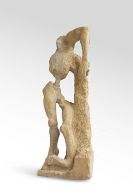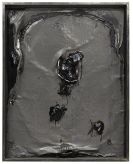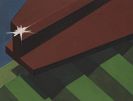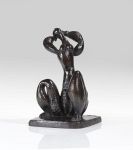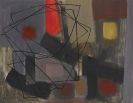
Alison Smithson
Sheffield
1928 -
London
1993
Born in Sheffield in 1928, the British architect and designer Alison Smithson studied architecture at Durham University, County Durham (not all that far from Newcastle-upon-Tyne), from 1944 to 1949, where she met Peter Smithson, whom she later married. In 1950 Peter and Alison Smithson moved to London. Peter and Alison Smithson, along with the artist Eduardo Paolozzo, Nigel Henderson, and others, belonged to the British avant-garde of their day, formulating their group aesthetic in terms of "as found".
In architecture this meant that the qualities specific to the place a building was to go up should be incorporated in the building; in addition, the properties of the building materials used should be left as far as possible in a raw state. "Brutalist" was the term soon coined for this school of architecture. Initially used in the broader sense, it was later only applied to the use of architectural concrete (béton brut).
The work of Ludwig Mies van der Rohe (Illinois Institute of Technology) and Le Corbusier was seminal for the Brutalist school of architecture. The Hunstanton Secondary School designed by Alison and Peter Smithson (150-54) is regarded as the building designed on Brutalist lines. The "as found" ideology was applied so radically to the Hunstanton project that the school's unfinished appearance met with almost universal rejection. The weight-carrying skeleton of the building consists of welded standard channel structural steel, the ceilings are made of prefab concrete slabs with the architectural concrete side showing, the brick façades, like the inside walls, have been left unrendered, and all electrical installation, pipes, and mains have been left exposed.
Other important building projects by Alison and Peter Smithson include Coventry Cathedral (1951) and the British embassy in Brasilia (1964). Between 1966 and 1972 Peter and Alison Smithson worked on designing "Robin Hood Gardens", a public housing complex in the East End of London, which again was not long in becoming a bone of contention since the architectural concrete aesthetic was decried as dreary.
As designers, Peter and Alison Smithson showed work at the 1956 exhibition "This is Tomorrow" mounted by the Independent Group at the Whitechapel Art Gallery in London. That same year the Smithsons designed "Trundling Turk", a block-like, low-slung armchair with foam upholstery that anticipated 1960s forms. In 1955 Peter and Alison Smithson designed the tubular steel and acrylic "Pogo" chair. The plastic "Egg" chair was designed for the Smithsons' 1956 "House of Tomorrow".
Would you like to sell a work by Alison Smithson?
Infos for seller

